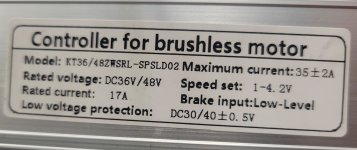Hello all, new here and looking for a little help/advice on direction to go with my current problem (apologies in advance for length of post).
I ran into a package deal on some used components online locally and got a package deal that included a couple Bafang 48v 750w rear hub motors.
Both had pulled/damaged wires and needed repair, but otherwise appear in near new condition with no signs of overheating or anything.
I've repaired one so far. I was able remove the damaged section of wire and have enough wire left to feed them back into the hub and resolder them in to the circuit board on the motor.
Ran it with the controller and throttle I planned to use on the bench and everything seemed great.
Laced the motor into the rim, and converted the bike.
Once everything was buttoned up, testing in the garage with wheel elevated, everything was still all good.
Smooth ramp up and smooth quiet running at all speeds.
Hop on for ride, and engaging the throttle from stop or low speed results in clunky motor chattering.
If I peddle and get a little speed going and then engage the throttle the bike performs as expected, and the motor is smooth and quiet.
As long as I have some speed going I can engage/disengage/re-engage the throttle with normal results/bike responds problem free.
Here are my components
Motor: Bafang rear hub "BF RMG06 48V750W(7)"
Controller: Brainpower 866-15
LCD display: s866 (sold as a package with controller)
Battery: Reention Polly DP-2170-5 48V 20AH 960WH for 1000W (new, known good)
Thumb throttle: TT-009
After some internet scouring I found a couple posts with people describing similar problems, but nothing concrete for a solution.
I found one thread that suggested hall sensor(s) issues that were overcome/nullified once some rotational speed was attained prior to engaging the throttle.
As that seemed to most closely match my issue I tested all three.
I believe my testing procedure is correct.
With all wiring and components still installed on the bike, and the wheel propped up I turned the power on at the controller and measured between the black wire and each hall sensor wire individually, slowly rotating the wheel in reverse.
All sensors measure 4.86v constantly, and don't appear to be cycling.
My questions.
1. With the wire damage history on the motor, is it likely that all hall sensors are bad?
2. When a hall sensor goes bad, does it just not cycle and read constant voltage, or more typically read consistent 0V?
3. Am I on the right track chasing "bad" hall sensors, or is there some other circuitry that could cause them not to cycle?
Thanks in advance for any help and advice!
I ran into a package deal on some used components online locally and got a package deal that included a couple Bafang 48v 750w rear hub motors.
Both had pulled/damaged wires and needed repair, but otherwise appear in near new condition with no signs of overheating or anything.
I've repaired one so far. I was able remove the damaged section of wire and have enough wire left to feed them back into the hub and resolder them in to the circuit board on the motor.
Ran it with the controller and throttle I planned to use on the bench and everything seemed great.
Laced the motor into the rim, and converted the bike.
Once everything was buttoned up, testing in the garage with wheel elevated, everything was still all good.
Smooth ramp up and smooth quiet running at all speeds.
Hop on for ride, and engaging the throttle from stop or low speed results in clunky motor chattering.
If I peddle and get a little speed going and then engage the throttle the bike performs as expected, and the motor is smooth and quiet.
As long as I have some speed going I can engage/disengage/re-engage the throttle with normal results/bike responds problem free.
Here are my components
Motor: Bafang rear hub "BF RMG06 48V750W(7)"
Controller: Brainpower 866-15
LCD display: s866 (sold as a package with controller)
Battery: Reention Polly DP-2170-5 48V 20AH 960WH for 1000W (new, known good)
Thumb throttle: TT-009
After some internet scouring I found a couple posts with people describing similar problems, but nothing concrete for a solution.
I found one thread that suggested hall sensor(s) issues that were overcome/nullified once some rotational speed was attained prior to engaging the throttle.
As that seemed to most closely match my issue I tested all three.
I believe my testing procedure is correct.
With all wiring and components still installed on the bike, and the wheel propped up I turned the power on at the controller and measured between the black wire and each hall sensor wire individually, slowly rotating the wheel in reverse.
All sensors measure 4.86v constantly, and don't appear to be cycling.
My questions.
1. With the wire damage history on the motor, is it likely that all hall sensors are bad?
2. When a hall sensor goes bad, does it just not cycle and read constant voltage, or more typically read consistent 0V?
3. Am I on the right track chasing "bad" hall sensors, or is there some other circuitry that could cause them not to cycle?
Thanks in advance for any help and advice!
Last edited:




